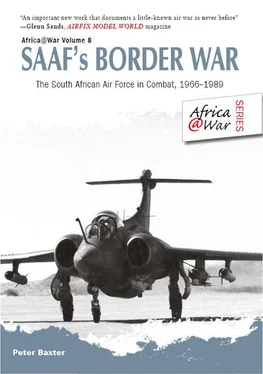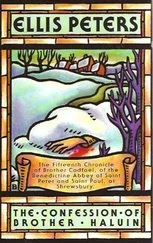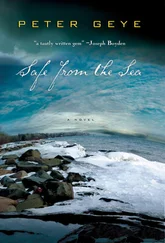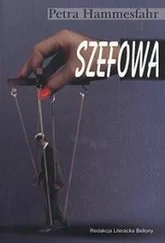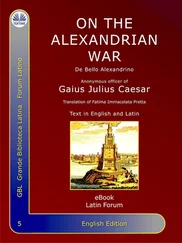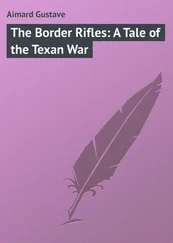Peter Baxter
SAAF’S BORDER WAR
The South African Air Force in Combat 1966-89
AAA – anti-aircraft artillery. Triple A was the overall term used to describe the anti-aircraft guns that were employed in limited numbers by SWAPO, but extensively by the Angolan defence force. These guns covered the complete spectrum of Soviet-supplied weaponry and included: 12.7mm, 14.5mm, 20mm, 23mm, 37mm, [1] This included the towed, twinbarrelled version that was probably the most widely employed and effective gun used in the entire campaign by either side, both in the ground-to-air and ground-to-ground mode. The four-barrelled, tracked version (Shilka) was also encountered. The 23mm cannons used by 32 Battalion, Koevoet and the SAAF were some of the many captured in operations over the years. Ironically, Angola probably became the biggest arms supplier to South Africa throughout the difficult years of arms boycotts.
57mm [2] These radarguided guns were originally equipped with the Fire-can radar system and later updated with the flap-wheel version.
ACF – Active Citizen Force (territorials)
ACM – air combat manoeuvring, modern name for dogfighting
ACS – Air Combat School
ADF – automatic direction-finding navigational instrument which locks onto an NDB
AFB – air force base
AFCP – air force command post. The SAAF uses a system of command posts to efficiently command and control all the resources available to it. This includes aircraft, personnel, radars, air-defence systems and ground security squadron specialists with their dogs. An AFCP controls the air force involvement in its designated area of responsibility, which includes both ground and air battles. An FAC is subservient to an AFCP but handles all the equivalent operations, except it does not control the air battle
AGL – above ground level, the height in feet that the aircraft flies above the ground
AI – air interception
AK-47 – Automat Kalashnikov type 47, a standard Soviet-designed automatic assault rifle
Alouette III – single-engine light helicopter, the aerial workhorse of the Border War. In the trooper role it could carry a crew of two plus four soldiers, or two stretchers when used in the casevac role. In the offensive role as a gunship it carried a 20mm cannon firing out of the port side
alpha bomb – circular-shaped anti-personnel bomb weighing 6kg that when dropped by the Canberra from level flight gave a natural dispersion pattern. The bomb would strike the surface, activating the fusing mechanism and then bounce into the air to detonate about 6m above ground. This bomb was an improved version of that used by the Rhodesian Air Force, and 300 of them could be loaded into the bomb bay of a Canberra
ANC – African National Congress
ATC – Air Traffic Control
ATCO – Air Traffic Control Officer
avtur – aviation turbine fuel used in helicopter and fixed-wing jet-turbine engines
bandit – an aircraft identified as hostile
BDA – bomb damaged area
beacon – the cut-line designating the border between Angola and Owamboland stretched in a straight line 420km from the Cunene River in the west to the Kavango River in the east. Every 10km a concrete beacon was built to identify position in an otherwise featureless terrain. Beacon 16 was therefore 160km east of the Cunene River.
blue job – anybody serving in the air force (slang)
BM-21 – 122mm 40-tube multiple-rocket launcher, mounted on a Ural 375 truck, with a maximum range of 20,000m
Boere – a general-usage, normally derogatory term used by both SWAPO and the Angolans to describe the South African/SWATF security forces (from the Afrikaans boer meaning farmer)
bogey–an unidentified aircraft
bombshell – guerrilla tactic of splitting up during flight (slang)
Bosbok – single-piston engine, high-wing reconnaissance aircraft flown by two crew seated in tandem. In the bush war it was utilized in many roles, including visual and photographic reconnaissance, skyshout, pamphletdropping and Telstar
brown job – any soldier; variations were ‘browns’ or the more commonly pongos (slang)
Buccaneer – S-50 version of the British-built naval strike fighter; twinengine, subsonic two-seater that could carry the full range of bombs plus AS-30 air-to-ground missiles
C-130 – four-engine turboprop heavy transport aircraft otherwise known as the Hercules. Used extensively throughout the bush war to support the actions of both ground-landing and air-dropping of personnel and freight ( see Flossie)
C-160 – twin-engine tactical transport aircraft. Although limited in payload when compared to the C-130, it had the decided advantage of a larger-dimensioned freight compartment, allowing easier and quicker transporting of helicopters to the battle area. Known by NATO as the Transall it had the dubious distinction of being probably the most difficult and expensive aircraft to maintain in the inventory of the SAAF owing to the extreme difficulties imposed by the international arms embargo
Canberra – English Electric twin-engine, medium jet bomber, used as such and also in PR roles. Armament included alpha bombs, World War IIvintage 500lb and 1,000lb general-purpose bombs plus the South Africanmanufactured 120kg and 250kg GP and pre-fragmentation bombs
CAP – combat air patrol, the armed mission air-defence fighters fly to ensure safety of own aircraft in the battle area
CAS – close air support; aircraft supporting the ground forces in close proximity to the immediate battle line are termed to be giving CAS
casevac – casualty evacuation
Casspir – mine-protected, armoured personnel-carrier
CEP – centre of error probability, a mathematical method of determining the miss-distance of a number of weapons from the centre of a target
Cessna 185 – a single-engine, four-seater tail-dragger used in the communication, skyshout, pamphlet-dropping and Telstar roles, by day and night
CFS – Central Flying School
CO – commanding officer
COIN – counter-insurgency
contact – a firefight, i.e. when contact is made with the enemy
cut-line – the border between Angola and Owamboland, so named from the graded strip cut through the bush to demarcate the international border
D-30 – Soviet-built 122mm cannon with a range of 15,000m; also used in an anti-tank role
Dayton – the radio call sign of the radar station situated at AFB Ondangwa; all matters concerning air defence were the responsibility of Dayton
density altitude – aircraft aerodynamic and engine performance are adversely affected by high temperatures and low pressures. Because these criteria vary from airfield to airfield and on a daily basis, the term ‘density altitude’ is used to determine aircraft performance. At sea-level airfields in Europe during winter, a jet aircraft will produce more thrust and lift than it will at AFB Waterkloof, 5,000ft AGL, during the 30°C-plus temperatures of summer
Читать дальше
